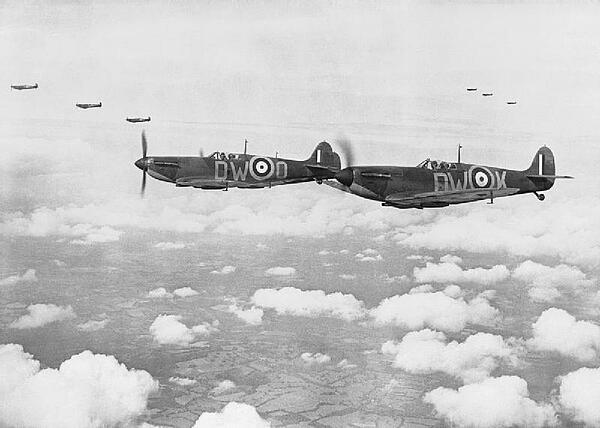Flying a Spitfire
For a newly qualified pilot, flying the Spitfire for the first time is likely to have been a daunting experience. A spitfire was a particularly fast aircraft, so much so that it outclassed any other aircraft of its kind including RAF trainer aircraft, and was also far more versatile.
In fact, Spitfires provided such as unique flying experience that it was generally assumed that any newly qualified Spitfire pilot who survived his first week of action in the Battle of Britain would have a high chance of surviving for the remainder.
A written guide, known as "Pilot's Notes", was supplied to all new pilots via the Air Council, and this would also be used as an aid for those hoping to become an expert in flying the Spitfire as quickly as possible. This guide provided information on several different areas, including how to take off, how to climb at altitude, how to maintain control of the aircraft, and what to do if the plane stalls during flight or diving manoeuvres.
See below to read the information given to pilots as part of this guide:

Take-off: “Open the throttle fully. Any tendency to swing can be counteracted by coarse us (sic) of the rudder. If taking off from a small aerodrome with a full load, max boost may be obtained by operating the boost control cut-out.
After raising the undercarriage, see that the red indicator light – UP – comes on (it may be necessary to hold the lever hard forward against the quadrant until the indicator light comes on).
Do not start to climb before a speed of 140 mph is attained.”
Climbing: “For maximum rate of climb the following speeds are recommended:
Ground level to 12,000 feet: 185 mph 12,000 feet to 15,000 feet: 180 mph 15,000 feet to 20,000 feet: 170 mph 20,000 feet to 25,000 feet: 160 mph” |
General Flying: “This aeroplane is stable. With metal covered ailerons the lateral control is much lighter that with the earlier fabric covered ailerons and pilots accustomed to the latter must be careful not to overstress the wings. Similar care is necessary in the use of the elevators, which are light and sensitive.
For normal cruising flight the radiator shutter should be in the minimum drag position.”
Stalling: “At the stall one wing will usually drop with the flaps either up or down and the machine may spin if the control column is held back.
This aeroplane has sensitive elevators and, if the control column is brought back too rapidly in a manoeuvre such as a loop or steep turn, stalling incidence may be reached and a high-speed stall induced. When this occurs there is a violent shudder and clattering noise throughout the aeroplane, which tends to flick over laterally and, unless the control column is put forward instantly, a rapid roll and spin will result.
Approximate stalling speeds when loaded to about 6,250 lbs are:
Flaps and undercarriage UP: 73 mph
Flaps and undercarriage DOWN: 64 mph”
Aerobatics: “This aeroplane is exceptionally good for acrobatics. Owing to its high performance and sensitive elevator control, care must be taken not to impose excessive loads either on the aeroplane or on the pilot and not to induce a high-speed stall. Many aerobatics may be done at much less than full throttle. Cruising rpm should be used, because if reduced below this, detonation may occur if the throttle is opened up to climbing boost for any reason.
The following speeds are recommended for acrobatics:
Looping – speed should be about 300 mph but may be reduced to 220–250 mph when the pilot is fully proficient.
Rolling – Speed should be anywhere between 180 and 300 mph. The nose should be brought up about 30 degrees above the horizon at the start, the roll being barrelled just enough to keep the engine running throughout.
Half roll off loop – speed should be 320-350 mph
Flick manoeuvre – Flick manoeuvres are not permitted.”
Diving - The aeroplane becomes very tail heavy at high speed and must be trimmed into the dive in order to avoid the danger of excessive acceleration in recovery. The forward trim should be wound back as speed is lost after pulling out. A tendency to yaw to the right should be corrected by use of the rudder trimming tab.”
MLA Citation/Reference
"Flying a Spitfire". HistoryLearning.com. 2025. Web.
